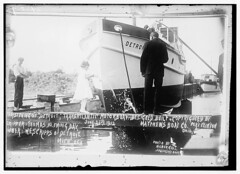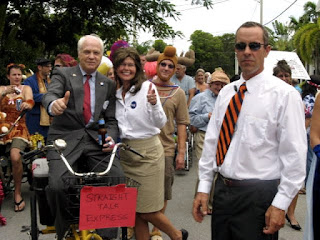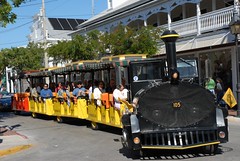 Here's a true story related to me an authentic Keys character. I've tried to retain some of the original language of the account. The names have been changed "to protect the guilty."
Here's a true story related to me an authentic Keys character. I've tried to retain some of the original language of the account. The names have been changed "to protect the guilty."Bunch of the boys was out in the Bay pulling traps. A crab trap cost about $20 at that time. Crab season was about over, and it was time to get your traps in, if you was going to do it. It was one of them clear days when you could see the bottom and everything on it. Generally the Bay was churned up, cloudy, not like the water on the Ocean side, which was cleaner and clear, even though the waves was higher on that side generally. The bay had more silt in it, and this is why it was usually stirred up. Also a lot of algae which the fishermen called gumbo. There was a lot of gumbo in the summer. But this was spring, and it was one of the first days that the bay was calm and clear. In close to shore schools of mullet stirred it up, but offshore where we was, the water was deeper and there wasn’t any mullet there. They was closer in, in the shallow creeks and flats in close to the Keys or the islands in the back country.
When it was that clear, sometimes you could see things you couldn’t see most of the year. For instance, large coral heads. A lot of people only thought you would see them things on the reef on the other side, but it’s a fact the bay is littered with them, here and there, where you’d never expect to see them. And they was always full of lobster, fish and other things. Sometimes you’d see the outline of a sunk boat. Sometimes it would be a boat that you knew, or used to know, like the one Cecil Davis lost out there after it burned years ago. (After his boat sunk, they throwed a party for him, a benefit-like, to help him get back on his feet, so to speak. The funny thing was, the son-of-a-bitch ended up with more money than he ever had, and he’d been a commercial fisherman his whole life!) We knew where it was, near Oxbow bank, and sometimes when we was pulling crab traps out near there we’d see it, but sometimes not. Some said it moved around, but I’m not sure about this.
So one day we was out there and it was clear and we saw the outline of another, really big boat. We wasn’t sure what it was, only that it was big, and not one we had seen ever before. We anchored up next to it, and put on masks and swam down to have a look, to see if there was anything still on it that we could take off. Sometimes there would be portholes or bronze fittings that people would pay good money for. But this boat was old, and there wasn’t too much left of it. After a while B comes up and says he sees some kind of a shape on it, square, and he wants to have a better look. He takes a metal bar and goes down and digs around it, like, and says it’s some kind of metal box. Things is lighter underwater. You can lift a cement block, for example, like it’s light like a piece of wood, not like a piece of cement which would be heavy up on the surface. But this box was so heavy that he couldn’t move it, and he was a big boy.
Eventually we got a line around the bottom of it. We have to dig around the bottom to do this. It took a couple of lines around it to get it hooked up, and then we all pulled like all get-out to haul the thing to the surface, but we couldn’t get the thing up into the boat. It was too heavy.
We had to kind of drag it through the water, alongside the boat. B called in to BW, his wife on the CB radio. He was kind of vague about what he was saying because anybody could have been listening, just said he was bringing in something heavy and that they should call C to see if he had something to rig up to get the thing out onto the land and to get it open. That’s all they had to hear. Couple of them bimbos had CB’s in their trailers at that time. They was always listening to what their old men was up to, and gossiping on them things the rest of the time.
So by the time we got in, there was a whole welcoming committee. In the meantime they had been speculating on what we had there, and had decided of course that it had to be some kind treasure.
Writers of crime stories often describe their subjects as being afficionados of treasure hunting magazines, the type that used to adorn the magazine racks of drugstores back in the Fifties. I was surprised to find that some of these are still published in this day and age. I suppose the underlying psychology has not changed, an appeal to the adventure seeking urban wage slave who never actually gets a chance to dive for the elusive flash of gold or any other romanticized activity. The idea of sunken treasure is a major archetype in the public psyche.
Today the same urge might be satisfied with the purchase of a power ball lottery ticket or a trip to the nearest Indian casino, with the lure of instant riches, if not adventure, and a small chance of actually coming away with something.
So they was talking, the way women do, about what they would do with the treasure when they got their hands on it.
“CV has always wanted a Monte Carlo,” one of them said. “That’s one of the first things we’re gonna get.”
“My old man’s gonna take me to Miami,” said another one. “We’re gonna go to the best hotel on the beach, and rent the penthouse suite. We’ll have one of them champagne bottle with the flowers on it.” No mention of who was going to take care of her snot-nosed kids, and no talk of buying anything sensible, or of setting any money aside for anything productive, like basic necessities or school things, or maybe even get her teeth fixed.
(One of the premises of Keynesian economic science is that when you put money into the hands of the poorer classes, they will immediately spend it.)They keep up their dreaming-out-loud. Then they start arguing about how what was the right way to share up the goods. So-and-so should get more because he saw it first.
“Shut yer whore’s mouth!” says B. "Right now everybody here is gonna get one piece of this. C is gonna get a share because he has the lift to get this thing up on the dock, and he’s got the tools to get the damn thing open."
They sent the bitches over to one side, out of the way where they could keep waggin’ their tongues without getting in the way. C got out his hammer and cold chisel, and started work on the chest. It took almost an hour, but finally he was able to pry the top off.
“What the hell IS this shit?”
Inside was a rusted mess of crystallized metal. They tore off a chunk. The women started to argue again.
“Let’s take it up to C’s trailer. He has a microscope.”
He not only had a microscope but also that basic tool of every treasure hunter, a Geiger counter. “Yeah, of course. You don’t have one?” he would say.It turned out that the entire contents of the mystery box was a rusted-together shipment of metal sewing needles.
Someone kicked the box back into the water, and it most likely sits on the bottom of that canal today.
As for the treasure ship itself, this was back in the days before G.P.S. No one really knew exactly where it was or what is was. Somebody said it might of been a Confederate paddle-wheeler, sunk trying to run the Union blockade way back when. Whatever she was, she is still out there today.
































